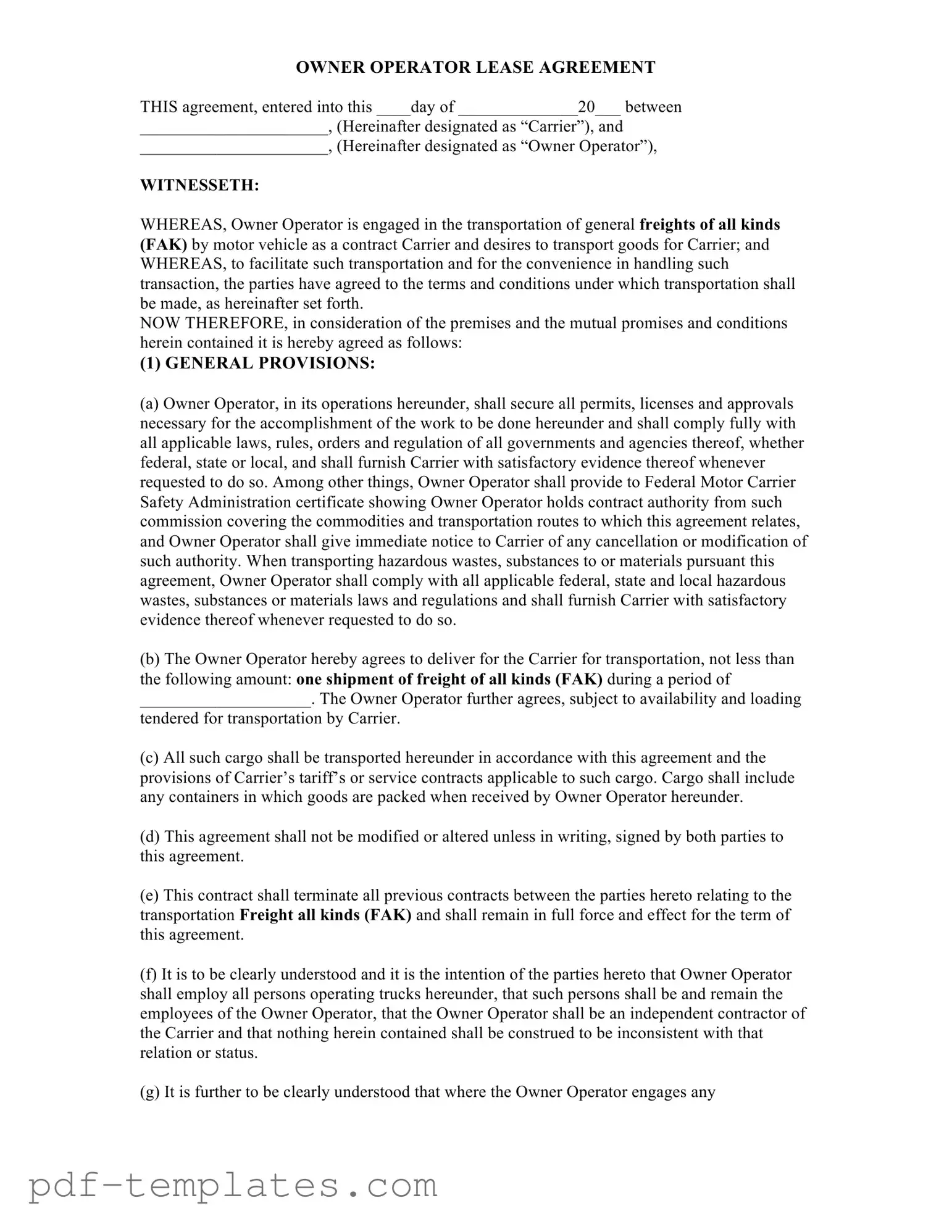The Owner Operator Lease Agreement shares similarities with a Freight Bill of Lading. Both documents serve as essential records in the transportation of goods. A Freight Bill of Lading acts as a receipt for the goods being transported, detailing the type and quantity of items. Similarly, the Owner Operator Lease Agreement outlines the responsibilities and obligations of both the carrier and the owner operator, ensuring that the transportation process is documented and understood by all parties involved. Each document emphasizes the importance of compliance with applicable laws and regulations, thereby reinforcing accountability in the shipping process.
Another document that resembles the Owner Operator Lease Agreement is the Independent Contractor Agreement. This type of agreement defines the relationship between a business and a contractor, much like the relationship between the carrier and owner operator. It clarifies that the owner operator is an independent contractor rather than an employee of the carrier. Both agreements outline the responsibilities of each party, including liability and indemnification, thus protecting the interests of both the carrier and the owner operator.
The Equipment Lease Agreement is also similar to the Owner Operator Lease Agreement. In this case, the equipment lease specifies the terms under which equipment is rented or leased. Just as the Owner Operator Lease Agreement outlines the terms for transporting goods, the Equipment Lease Agreement details the responsibilities for maintaining and using the leased equipment. Both agreements emphasize the importance of adhering to regulations and ensuring that all parties fulfill their obligations.
A Carrier Agreement is another document with parallels to the Owner Operator Lease Agreement. This document outlines the terms under which a carrier agrees to transport goods for a shipper. Both agreements include provisions regarding liability, insurance, and compliance with applicable laws. They serve to protect the interests of the parties involved while ensuring clarity in the transportation process.
In understanding various legal documents related to business arrangements, it's also important to acknowledge the educational sector, particularly for those opting for homeschooling. The process begins with submitting a formal notification to local authorities, which can be efficiently managed through the Homeschool Letter of Intent form. This documentation serves as a foundation for establishing educational pathways outside traditional settings, much like the agreements discussed that help outline obligations and relationships in business.
The Transportation Service Agreement is akin to the Owner Operator Lease Agreement as well. This type of agreement defines the terms of service between a transportation provider and a client. It includes details about rates, responsibilities, and compliance with regulations, similar to the provisions found in the Owner Operator Lease Agreement. Both documents aim to establish a clear understanding of expectations and responsibilities in the transportation of goods.
The Master Service Agreement (MSA) is another document that shares similarities with the Owner Operator Lease Agreement. An MSA outlines the general terms and conditions that govern a long-term business relationship. Like the Owner Operator Lease Agreement, it addresses liability, compliance, and the responsibilities of each party. Both documents are designed to streamline future agreements by providing a framework for collaboration.
The Joint Venture Agreement can also be compared to the Owner Operator Lease Agreement. This document outlines the terms of a partnership between two or more parties to undertake a specific project or business activity. Similar to the Owner Operator Lease Agreement, it defines the roles and responsibilities of each party, including liability and compliance with laws. Both agreements emphasize the importance of collaboration and mutual understanding in achieving common goals.
Lastly, the Bill of Sale can be viewed as a related document. A Bill of Sale serves as a legal document that transfers ownership of goods from one party to another. While it focuses on the transfer of ownership, it shares the common theme of documenting transactions and ensuring compliance with applicable laws. Both the Bill of Sale and the Owner Operator Lease Agreement provide necessary documentation that supports the legal transfer and transportation of goods.
